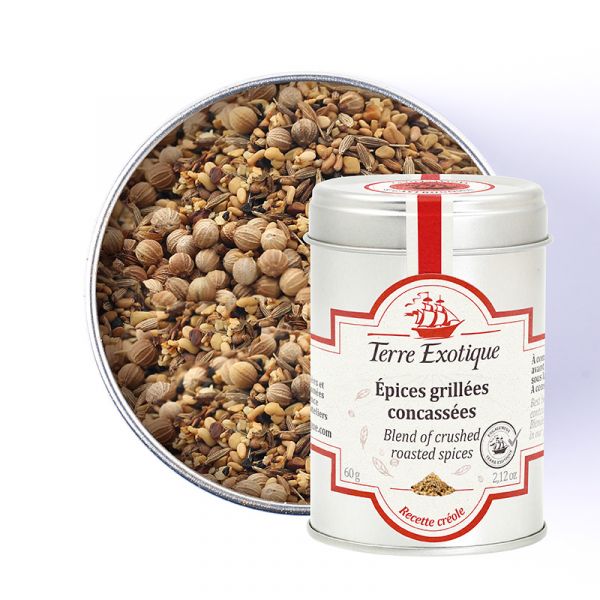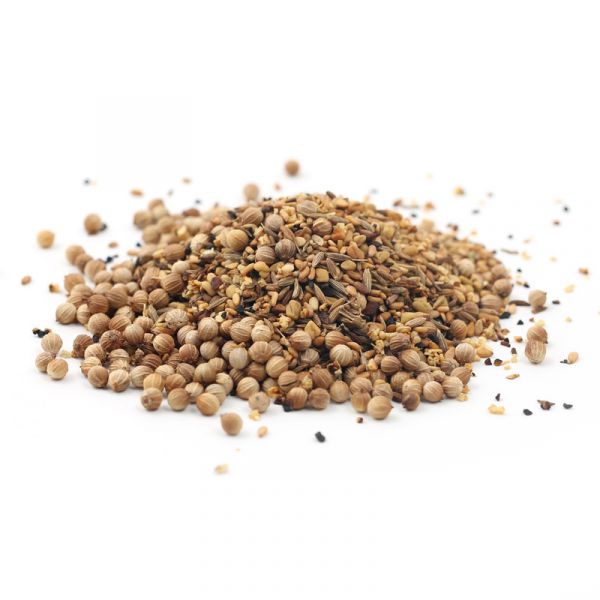





How to Incorporate Crushed Roasted Spices into Your Cooking?
This harmonious blend of roasted spices will enhance soups, tomato carpaccio, marinated meats, and crunchy vegetables. Its bitter yet warm, slightly sweet flavors, and highly assertive aromas will elevate a chili con carne or a lamb parmentier!
Some Recipe Ideas for Using Crushed Roasted Spices
- - Grilled shrimp with crushed roasted spices : Marinate peeled shrimp in a mixture of olive oil, lemon juice, and the crushed roasted spice blend. Grill them quickly for a deliciously fragrant dish;
- - Roasted chickpeas : Coat cooked chickpeas in the crushed roasted spice blend, add a drizzle of olive oil, then roast them in the oven until crispy;
- - Spiced oven-baked chicken : Brush chicken pieces with plain yogurt and the crushed roasted spice blend. Bake them in the oven to achieve crispy skin and deep flavors;
- - Barbecue-grilled vegetables : Toss vegetables such as zucchini, bell peppers, and mushrooms with the crushed roasted spice blend and olive oil, then grill them on the barbecue;
- - Herbed and spiced couscous : Add the crushed roasted spice blend to your couscous during cooking for robust and flavorful taste. Also, add fresh herbs for a touch of freshness;
- - Grilled salmon with spice blend: Season salmon fillets with the crushed roasted spice blend and grill them for a tasty fish option.
The Aromas of Crushed Roasted Spices
Sesame seeds add a delicate hazelnut note, while garlic contributes its spicy and aromatic flavor. Coriander brings fresh and lemony accents, balanced by the warm and earthy tones of cumin. Fenugreek adds a slightly bitter and sweet nuance. Roasting gives the spices grilled aromas and toasted notes reminiscent of caramel and hazelnut. To develop the delicate aromas of the spices, the roasting process is slow and delicate.
A Thousand and One Plants
Sesame, or Sesamum indicum, is an oilseed plant native to Africa and India, which produces seeds rich in oil, known for their famous sesame oil. Garlic, or Allium sativum, is native to Central Asia. It is mainly cultivated for its edible bulbs. Next, we have coriander or Coriandrum sativum, an aromatic herb used for its leaves and seeds. Cumin or Cumimum cyminum is a plant native to the Middle East and the Mediterranean, appreciated for its warm flavors. Finally, fenugreek or Trigonella foenum-graecum, is a herbaceous plant from the Middle East, grown for its leaves and seeds with a slightly bitter taste.
Each Spice Requires its Own Cooking
Each spice in this blend is roasted by hand, at a constant temperature and without adding fat. The temperature and roasting time vary depending on each type of spice, its size, its moisture content, and the desired taste.
| Allergen | Sésame, sulfites / Sesame, sulphites |
|---|---|
| Native country | FRANCE |
| Ingredients | SESAME, garlic (SULPHITES), coriander, cumin, fenugreek. |
| Nutritional Info | VN Energie pour 100 g (energy for 100g) : 1754 kJ / 419 kcal VN Matière grasse (fat) : 22 g Dont acide gras saturés (of which saturated fat) : 3 g VN Glucides (carbohydrate) : 29 g Dont sucres (of which sugars) : 2 g VN Protéines (protein) : 19 g Vn Sel (salt) : 0.18 g |
| TRACES EVENTUELLES D'ALLERGÈNES | céleri, sésame, moutarde, fruits à coques. |
 Français
Français 